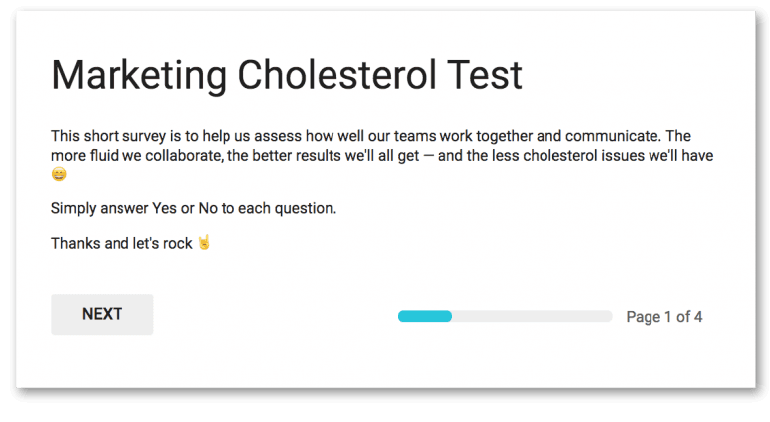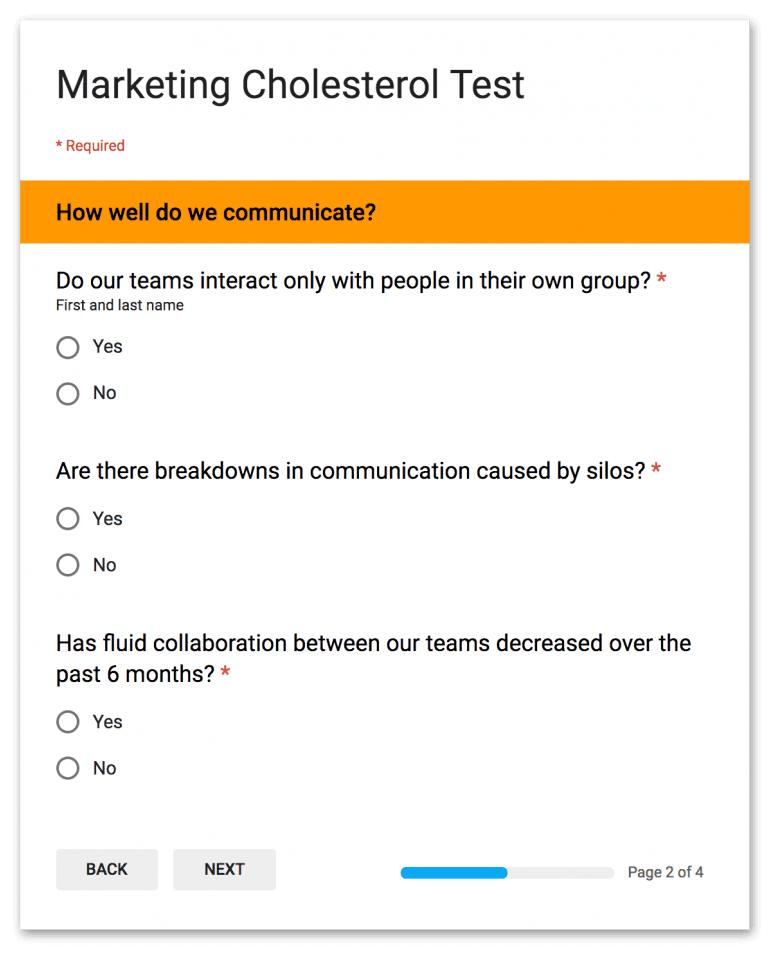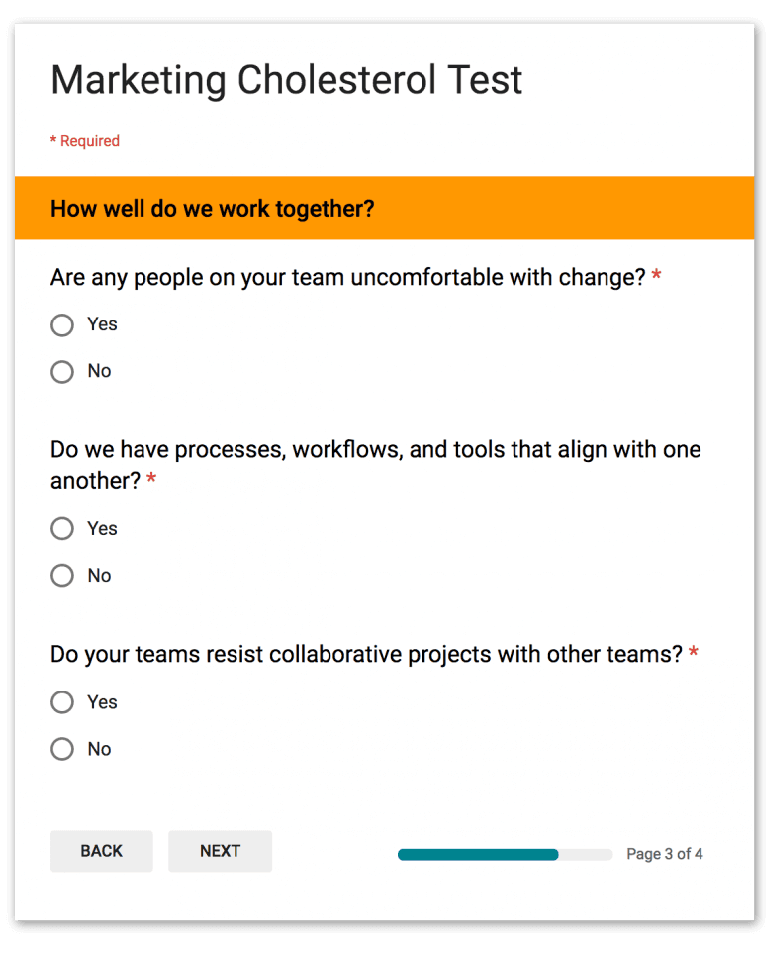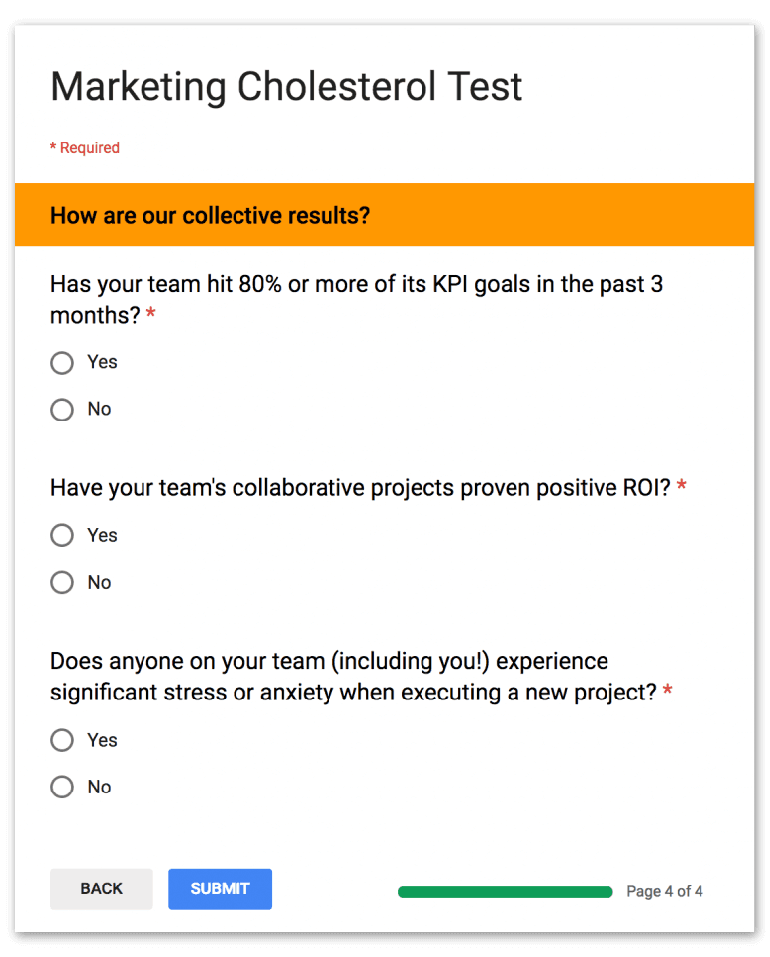3 Uncommon Ways To Get Team Buy In Every Time
 You probably already know a few of the tips and tricks to getting team buy in to new ideas, processes, or change.
When it comes to influencing your peers, though, it can be a delicate dance.
Because you lack positional authority, you can't pull the, "Well, that's the way we're going to do it," card.
You probably already know a few of the tips and tricks to getting team buy in to new ideas, processes, or change.
When it comes to influencing your peers, though, it can be a delicate dance.
Because you lack positional authority, you can't pull the, "Well, that's the way we're going to do it," card.
 (Not that you ever would ?)
But these three off-beat tactics I'm sharing will work for you.
Today.
We'll lay some groundwork first. But if you wanna jump ahead, be my guest.
Each strategy will work for peer or team buy in.
(Not that you ever would ?)
But these three off-beat tactics I'm sharing will work for you.
Today.
We'll lay some groundwork first. But if you wanna jump ahead, be my guest.
Each strategy will work for peer or team buy in.
3 Uncommon Ways To Get Team Buy In Every Time via @Coschedule
Click To TweetDid Isaac Newton Already Figure Out Why We Resist Change?
Neurologically, we're hard wired to maintain things as they are via our ingrained habits. We're comfortable in the rut of status quo. And any threat to it is perceived as discomfort — which humans avoid tooth and nail. Said psychologist Ralph Ryback:"Inertia, or 'a tendency to do nothing or to remain unchanged,' is at the headwinds of any change that we make in our lives."Wildly enough, Isaac Newton's principle of inertia applies to our psychology as well as the world around us. One of the best places to validate this is in the world of software — in both simple and complex ways. Remember when Spotify changed its hue of green a few years ago? Millions of us were used to their funky green. It wasn’t beautiful, but it was normal. Then, they warmed up the color in favor of the vibrant lime green.
 Thousands of users whined at the ugly new color scheme.
I’ll admit, I didn’t like it at first either.
Oh yeah…
...then there’s the Snapchat UI updates that just about broke the internet.
People hated the updates so much, there were riots in the streets!
Thousands of users whined at the ugly new color scheme.
I’ll admit, I didn’t like it at first either.
Oh yeah…
...then there’s the Snapchat UI updates that just about broke the internet.
People hated the updates so much, there were riots in the streets!
 Okay, not quite that bad. But, the backlash was so intense, 1,257,640 users signed a petition on Change.org to get the old UI back.
Okay, not quite that bad. But, the backlash was so intense, 1,257,640 users signed a petition on Change.org to get the old UI back.
 On a societal scale, people are change averse. We often have negative initial reactions to both functional and visual changes.
This means “different” is often perceived as “bad.”
On a societal scale, people are change averse. We often have negative initial reactions to both functional and visual changes.
This means “different” is often perceived as “bad.”
The perception that different = bad often blocks positive organizational change. Learn how to overcome it via @CoSchedule here:
Click To Tweet"I'm in favor of progress; it's change I don't like."Back to the Top
What Does Leading Change Look Like For Marketers?
In user experience design, this is known as change aversion:"Change aversion is the negative short-term reaction to changes in a product or service."This happens in the non-digital world, as well. And is a force we marketers have to battle when leading change (especially within our own companies). Now, let's learn how to go out with the old and in with the new. One of the most important changes marketers should make is killing makeshift marketing. Makeshift marketing has become the normal way marketers do things today. It's the pain of using one tool for social media scheduling... Another tool for analytics... A spreadsheet for tracking... Endless email threads for collaboration and communication... A task management tool (or multiple ones if everyone on your team uses something different)... We get caught in a mess of using tons of different productivity tools that end up strangling our output rather than boosting it. Another force at work is that complicated tool stacks are actually celebrated with awards. To bring it a little closer to home, let's ask a question. You’re executing marketing today... How’s that going? Staying organized is really hard.
- You’re missing deadlines,
- your team is disgruntled,
- your boss is wondering what’s happening,
- and stakeholders like your sales reps are constantly asking where their projects they requested three months ago are at.
Overcoming Change Aversion In Your Team
However, everyone is used to the way things are. So, if you're going to overcome the forces allied against you as a leader, you've gotta be armed with the right strategies. So let's tackle three off-beat ways to overcome change aversion. Obliterate the status quo. And become a more influential leader while you're at it. Back to the Top#1. Take The "Marketing Cholesterol Test" To Get Team Buy In
To start, you might need to prove that change is actually required right now. When you create urgency, at least people can agree that, "We need to do something." One ingenious assessment for your organization's need to change appeared in the Harvard Business Review, and is called the "Corporate Cholesterol Test." You can check out the original test in the article "Change For Change's Sake." But here's an adaptation for us marketers to use. The test's purpose is to assess how well your teams (or team members) are working together. Thus... Measuring how high your collaborative cholesterol is ?How high is your marketing cholesterol? Find out what that means and learn the answer via @CoSchedule here:
Click To Tweet The test starts the buy-in process by helping your peer managers see for themselves if change is needed.
You'll create three sections. Each with three yes or no answers.
The test starts the buy-in process by helping your peer managers see for themselves if change is needed.
You'll create three sections. Each with three yes or no answers.
- How well do we communicate?
- How well do we work together?
- How are our collective results?
Section One: "How well do we communicate?"
 In section one, you'll ask these three yes or no questions:
In section one, you'll ask these three yes or no questions:
- Do our teams interact only with people in their own group? This questions identifies the presence of silos.A silo mentality "occurs when several departments or groups within an organization do not want to share information or knowledge with other individuals in the same organization."Basically it's a problem of key info staying stuck in one group rather than shared with others it could help.
- Are there breakdowns in communication caused by silos? If there are silos, this will be a big fat yes ?This is a great opportunity to understand it as a source of frustration. And you can position your change as a cure.
- Has fluid collaboration between our teams decreased over the past 6 months? This is an easy way to gauge how well your teams have worked together. If this is a "Yes," it's another sign that the winds of change should be blowing!
How can marketers know they're influencing positive organizational change? Find out via @CoSchedule here:
Click To TweetSection Two: "How well do we work together?"
 In section two, you'll ask these three yes or no questions:
In section two, you'll ask these three yes or no questions:
- Are any people on your team uncomfortable with change? Now, admittedly, this question is a double-edged sword ⚔️After all, change is uncomfortable for pretty much everyone. But, as Sujan Patel writes, this is crucial to success.The crux of this question is to bring to mind the proverbial roadblocks to change...The people on their team whose automatic answer is, "No."
- Do we have processes, workflows, and tools that align with one another? I know this is buried in the middle of the survey... But it's my favorite question.This digs into the heart of a central problem for marketers today. We call it makeshift marketing......and think of it as the temporary, sub-optimal solution for getting your marketing sh*t together. This is not #fakenews.I can't tell you how many marketers I've met whose solution for “keeping their sanity” involves spreadsheets organizing spreadsheets.Who’ve decided endless meetings to “get on the same page” is par for the course.Who’ve succumbed to “on the fly” project management because that’s just the nature of the job?!And who’ve settled for a cobbled mess of one-trick tools because...well…?That's just how marketing works ?In fact, this is one of the biggest problems CoSchedule solves (you can snag a free 1-on-1 demo to learn how it can help you do this!).Teams pay a HUGE productivity tax for misaligned processes, workflows, and tools.If this is a yes, it's a red flag ?
- Do your teams resist collaborative projects with other teams?
 Here's a newsflash...If people on your peer manager's team resist collaboration, it's prolly not because they're bad people. Or employees.Did you know that 85% of most workers' time is spent in email, meetings, and being on the phone?So maybe they resist working with other teams because they have so freaking much to do and not enough time!^^^ Sound familiar to you?If this is the case, it's time to get efficient and make better use of people's time.After all, who would resist: "Here, would you like less stress while getting your time back and feeling more valued?"If you're leading the right change, this can be exactly what you're giving them.What if collaboration could be a source of excitement and growth......rather than a drain?
Here's a newsflash...If people on your peer manager's team resist collaboration, it's prolly not because they're bad people. Or employees.Did you know that 85% of most workers' time is spent in email, meetings, and being on the phone?So maybe they resist working with other teams because they have so freaking much to do and not enough time!^^^ Sound familiar to you?If this is the case, it's time to get efficient and make better use of people's time.After all, who would resist: "Here, would you like less stress while getting your time back and feeling more valued?"If you're leading the right change, this can be exactly what you're giving them.What if collaboration could be a source of excitement and growth......rather than a drain?
Section Three: "How are our collective results?"
 In section three, you'll ask these three yes or no questions:
In section three, you'll ask these three yes or no questions:
- Has your team hit 80% or more of its KPI goals in the past 3 months? Simply put, if teams aren't hitting their goals for more than 3 months in a row — something's gotta change.This is a chance to highlight how your suggested change can help everyone's tide rise.
- Have your team's collaborative projects proven positive ROI? This is an interesting one. Because some of your peer managers might say, "What collaborative projects?"Again, this could stem from silo issues... Or signal a breakdown in teams working together.For instance, nearly every modern marketing teams should be working with developers (who are often outside their team) regularly.Next, if they have worked with other teams...Well, has it worked?Are there more dollars, email signups, or whatever else they were looking for because of the joint venture?
- Does anyone on your team (including you!) experience significant stress or anxiety when executing a new project? I absolutely love this question.While there is always *some* amount of stress kicking off a new project — it shouldn't be consistently significant.Scientifically, we know significant stress reduces productivity. It also promotes negative behaviors like procrastination. So if new projects give your team a panic attack, something major is broken.Now is the time to fix it.
How To Score Your Marketing Cholesterol Test (In GIFs)
Alright, here's the final reveal... Score your test responses as follows: 0–2 yes answers You're good and probably rock at getting your peers to buy in.
3–7 yes answers
You're good and probably rock at getting your peers to buy in.
3–7 yes answers
 Right now is the perfect time for change! Saddle up and get it done.
8–9 yes answers
Right now is the perfect time for change! Saddle up and get it done.
8–9 yes answers
 Panic. It was time to change yesterday...
...but today is good too.
You got this ?
Panic. It was time to change yesterday...
...but today is good too.
You got this ?
#2. Start With The Problem To Get Team Buy In
Next, to overcome change aversion with your peer managers, start with the problem you’re trying to solve and the benefits your solution offers to them. Yes... ...I’m encouraging you to market change to marketers. #inception
Software has more to teach us, here.
Intercom recently revamped the design of their product's inbox — a place their customers spend a lot of time in.
The new interface looks like Evernote and Intercom had a baby... And it's one cute baby.
They got ahead of change aversion by focusing on problem their change was geared at solving.
Often, change is resisted with statements like this: "We don't need to change for change's sake!"
If you begin with the problem, though, you sidestep this as an issue altogether.
When there's a genuine problem to be solved, you aren't changing for change's sake. Your changing for growth's sake.
Huge difference.
#inception
Software has more to teach us, here.
Intercom recently revamped the design of their product's inbox — a place their customers spend a lot of time in.
The new interface looks like Evernote and Intercom had a baby... And it's one cute baby.
They got ahead of change aversion by focusing on problem their change was geared at solving.
Often, change is resisted with statements like this: "We don't need to change for change's sake!"
If you begin with the problem, though, you sidestep this as an issue altogether.
When there's a genuine problem to be solved, you aren't changing for change's sake. Your changing for growth's sake.
Huge difference.
Trying to influence positive change within your marketing department? Start with the problem first.
Click To TweetStart With The Problem
First, specifically outline the problem you want to solve and the harm it's causing. Outline the problem as specifically as you can:"Right now, we're using six different tools to manage our marketing. Because of the constant shuffle, details are getting lost, we're dropping balls, and not hitting deadlines."
Outline Your Solution
Propose your solution, address the cost of switching, and focus on the benefits:"If we consolidate our tools, these problems will evaporate. We each lead talented, competent teams. So it's a simple thing to give them a better way to do their jobs. Yes, this will mean adapting our workflows to a fresh way of doing things. And it will mean a new way of collaboration among our teams. But the gain in productivity and organization will pay dividends in results, reduce stress, and improve communication."When you focus on the problem, your proposed change isn't the focal point. Admittedly, I'm assuming the change you want to lead is truly an issue. If it is, you can position any resistance to be against the benefits your solution offers. This keeps the conversation focused on, "How do we solve this real problem." Back to the Top
#3. Script The New Actions The Change Requires To Get Team Buy In
A third way to get your peer managers to buy in comes from Chip and Dan Heath's fantastic book, Switch: How To Change Things When Change Is Hard. It's a way to get ultra-specific about what needs to happen next. The catchphrase "analysis paralysis" turns out to be a real thing. It even happens to LeBron James. When people are presented with too many options, we get stuck.
When people are presented with too many options, we get stuck.
When people are presented with too many options, we get stuck.
Click To TweetAnalysis Paralysis Is A Real Thing
In the book Switch, the authors share how this same phenomenon happens to doctors. A medical doctor and a psychologist devised a test to see how well the average doc make choices. The test involved two similar groups asked to make a decision on the same case. The only difference was that Group A made a choice between two options. While Group B had three. Check out the scenario... The patient in the test was an older gentleman with hip trouble. Group A had to decide between a hip-replacement surgery and a simple medication that hadn't yet been tried. Almost 50% of the doctors from Group A chose the non-surgical path. Group B had a similar choice. Only instead of one non-surgical option, there were two. That's it. That was the only variable. These doctors had to decide on surgery, medication 1, or medication 2... Logically, two non-surgical options seem even better than one, right? Well, only 28% of Group B docs opted for the non-surgical option. ^^^ This is analysis paralysis at work.How can marketers overcome analysis paralysis and drive real positive organizational change?
Click To TweetHow To Overcome The Curse Of Analysis Paralysis
So, if this affects everyone from world-class athletes to doctors, it's a force we all have to deal with. The authors of Switch have an answer for us. They call it "scripting the critical moves." They explain:Change begins at the level of individual decisions and behaviors, but that's a hard place to start because that's where the friction is. Inertia and decision paralysis will conspire to keep people doing things the old way. To spark movement in a new direction, you need to provide crystal-clear guidance.Here's how it works. You can't script out people's every action. But you can give them frameworks for taking the right actions at the critical times. Here's a perfect example many of our customers face (and you probably do, too).
How To Script The Critical Action In Marketing
Marketing teams adopt CoSchedule to organize and run all of their marketing in one place. But they're up against the makeshift marketing problems I've described. This means the habits of doing things the "old way" can be problematic. For instance, instead of communicating about a project in the comments thread using the tool itself, like so... It's easy to send a "quick" email or IM instead.
Now the entire team lacks visibility into info that might be mission critical.
This example can repeat itself ad nauseam...
It's easy to send a "quick" email or IM instead.
Now the entire team lacks visibility into info that might be mission critical.
This example can repeat itself ad nauseam...
- Creating more spreadsheets.
- Building another project request form.
- Writing copy in a Word Doc.
If it's about the project, it goes in the project.
 Each color-labeled item on the calendar is a project that contains ALL of the project communication, content, deadlines, and details.
So, a simple script for people to follow makes it super easy to change their behavior.
If it's about the project, it goes in the project.
The decision is made ahead of time.
No one has to think.
No one gets stuck in analysis paralysis wondering, "Where should this go?"
Each color-labeled item on the calendar is a project that contains ALL of the project communication, content, deadlines, and details.
So, a simple script for people to follow makes it super easy to change their behavior.
If it's about the project, it goes in the project.
The decision is made ahead of time.
No one has to think.
No one gets stuck in analysis paralysis wondering, "Where should this go?"
It's Time To Get Team Buy In Every Time
Now you have three awesome tactics to get your peers and team to buy in every time.- Use the marketing cholesterol test to help your peers realize change is needed.
- Start with the problem to help your peers (and team) focus on the results your change will achieve.
- Leverage the power of scripting the critical moves to make it easy for people to avoid analysis paralysis.
- It's time to change...
- You'll get awesome results by changing...
- Here's how easy it is to change...
 Or create your free marketing calendar.
Or create your free marketing calendar.

